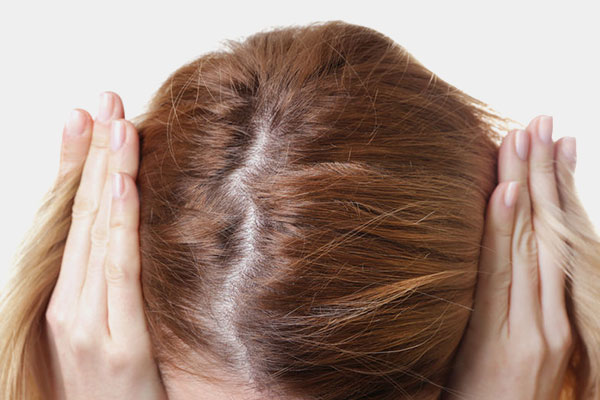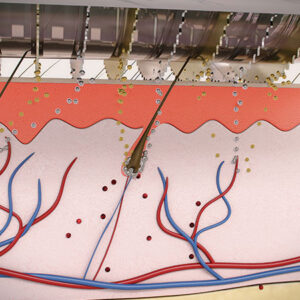Alopecia, a term that encompasses various forms of hair loss, can significantly impact a woman’s self-esteem and emotional well-being. Among the different types of alopecia, female pattern baldness is one of the most common. Understanding the signs of alopecia in women is crucial for early detection and intervention. This article will delve into the various manifestations of hair loss in women, explore the underlying causes, and discuss available treatment options, including innovative devices like the Hairegen.

Recognizing the Signs of Alopecia in Women
Gradual Thinning of Hair
One of the earliest indicators of alopecia in women is a gradual thinning of hair, particularly at the crown and top of the head. Unlike male pattern baldness, which often leads to receding hairlines, female pattern baldness tends to manifest as an overall thinning, primarily affecting the part line. Women may notice that their hair appears less voluminous and that they are shedding more strands than usual during everyday activities, such as brushing or washing.
Widening of the Part
As hair loss progresses, many women experience a noticeable widening of their center part. This change can become particularly evident when styling hair, as the scalp may become more visible. Some women may find that their part begins to resemble a “Christmas tree” shape, with thinning hair extending outward from the center. This symptom can serve as a red flag, indicating that further evaluation may be necessary.
Circular or Patchy Bald Spots
In some cases, women may develop circular or patchy bald spots, which can occur suddenly. This form of hair loss, known as alopecia areata, can affect not only the scalp but also other areas, such as the eyebrows and eyelashes. The patches can vary in size and may sometimes be accompanied by itching or discomfort. If you notice these symptoms, it’s essential to consult a healthcare professional for a proper diagnosis and treatment plan.
Changes in Hair Texture
Another sign of alopecia in women is a change in hair texture. As hair follicles shrink, the individual strands may become finer and shorter. Women might observe that their hair feels coarser or more brittle than before. This alteration in texture can be particularly concerning, as it may indicate that hair growth is being compromised.
Nail Changes
Interestingly, alopecia can also manifest through changes in the nails. Some women may notice pitting, ridges, or other abnormalities in their nails. These changes can be subtle but may indicate an underlying autoimmune response associated with hair loss. If you experience any concerning nail changes alongside hair loss, it’s essential to discuss these symptoms with your healthcare provider.
Understanding the Causes of Alopecia in Women
Genetic Predisposition
One of the primary factors contributing to alopecia in women is genetics. Family history plays a significant role in determining an individual’s likelihood of experiencing hair loss. Women with relatives who have experienced pattern baldness are at a higher risk of developing similar conditions. This hereditary aspect underscores the importance of understanding one’s family medical history.
Hormonal Changes
Hormonal fluctuations can significantly impact hair health. Conditions such as pregnancy, menopause, and thyroid disorders can lead to alterations in hormone levels that may trigger hair loss. For instance, during menopause, a decrease in estrogen can contribute to thinning hair. Understanding how hormonal changes affect hair follicles can help women identify potential triggers for their hair loss.
Autoimmune Disorders
Alopecia areata is an autoimmune condition where the immune system mistakenly attacks hair follicles, leading to patchy hair loss. This condition can occur in individuals without a family history of hair loss and may be linked to other autoimmune disorders. Women experiencing sudden hair loss should consider consulting a healthcare professional to evaluate for possible autoimmune conditions.
Medical Treatments and Medications
Certain medical treatments and medications can lead to hair loss as a side effect. Chemotherapy, for example, is well-known for causing significant hair loss in women undergoing cancer treatment. Additionally, medications for conditions such as high blood pressure, arthritis, and depression may also contribute to hair thinning. If you suspect that your medication may be affecting your hair, it’s important to discuss this with your doctor.
Stress and Lifestyle Factors
Stress is another crucial factor that can exacerbate hair loss. Emotional or physical stressors can lead to a condition known as telogen effluvium, where hair follicles enter a resting phase and hair shedding increases. Lifestyle factors such as poor nutrition, lack of exercise, and inadequate sleep can also contribute to hair health. Women should prioritize self-care and stress management techniques to promote overall well-being.

Best selling hair growth products:
Diagnosing Alopecia in Women
Clinical Evaluation
Diagnosing alopecia in women typically begins with a thorough clinical evaluation. A healthcare provider will assess the pattern and extent of hair loss, taking into account the patient’s medical history and any associated symptoms. This evaluation may include a physical examination of the scalp and hair follicles to identify any abnormalities.
Blood Tests and Scalp Biopsy
In some cases, additional tests may be necessary to determine the underlying cause of hair loss. Blood tests can help assess hormone levels, thyroid function, and nutritional deficiencies. A scalp biopsy may also be performed to examine the hair follicles more closely, particularly if an autoimmune condition is suspected.
Family and Medical History
Understanding family and medical history is essential in diagnosing alopecia. A detailed discussion about any relatives who have experienced hair loss can provide valuable insights. Additionally, documenting any recent changes in health, medications, or lifestyle can help healthcare providers identify potential triggers for hair loss.
Treatment Options for Alopecia in Women
Medications
Several medications are available to treat alopecia in women. Minoxidil, an FDA-approved topical solution, is commonly used to promote hair regrowth. Available in both 2% and 5% formulations, minoxidil can help slow hair loss and stimulate new growth in some women. However, it’s important to note that results may vary, and continuous use is necessary to maintain any benefits.
Hormonal Therapies
For women experiencing hair loss related to hormonal changes, hormonal therapies may be an effective option. Medications such as spironolactone or oral contraceptives can help balance hormone levels and reduce hair loss associated with androgens. Consulting with a healthcare provider to determine the most appropriate hormonal treatment is essential.
Hair Transplant Surgery
For women who do not respond well to medical treatments, hair transplant surgery may be a viable option. This procedure involves relocating hair follicles from areas of the scalp with healthy hair to thinning or balding areas. While hair transplant surgery can yield permanent results, it is essential to have realistic expectations and discuss potential risks with a qualified specialist.
Innovative Treatments: The Hairegen Device
The Hairegen device is a cutting-edge solution designed to address hair loss in women. Utilizing low-level laser therapy (LLLT), this device stimulates hair follicles and promotes hair growth. The Hairegen device is non-invasive and can be used in the comfort of one’s home. Many users have reported positive results, making it a promising option for those seeking to combat alopecia.
Lifestyle Modifications
In addition to medical treatments, lifestyle modifications can play a significant role in promoting hair health. A balanced diet rich in vitamins and minerals, particularly those known to support hair growth, can be beneficial. Incorporating regular exercise, managing stress levels, and avoiding harsh hair treatments can also contribute to healthier hair.
Coping with the Emotional Impact of Alopecia
Understanding the Psychological Effects
The emotional toll of hair loss can be profound. Women experiencing alopecia may face feelings of embarrassment, anxiety, and depression. Understanding that these feelings are valid is crucial for coping with the psychological effects of hair loss.
Seeking Support
Connecting with support groups or counseling can provide valuable resources for women dealing with the emotional challenges of alopecia. Sharing experiences with others who understand the struggles can foster a sense of community and empowerment.
Embracing Change
Learning to embrace changes in appearance can be an essential part of coping with alopecia. Many women find that experimenting with different hairstyles, wigs, or head coverings can help them feel more confident and comfortable in their skin.
Prevention Strategies for Alopecia in Women
Healthy Lifestyle Choices
While there is no guaranteed way to prevent alopecia, adopting healthy lifestyle choices can promote overall hair health. A diet rich in antioxidants, vitamins, and minerals can support hair follicles and reduce the risk of hair loss. Regular physical activity and stress management techniques can also contribute to healthier hair.
Regular Scalp Care
Maintaining a healthy scalp is vital for preventing hair loss. Gentle cleansing, moisturizing, and avoiding harsh chemicals can help preserve the integrity of hair follicles. Regular scalp massages may also stimulate blood flow and promote hair growth.
Monitoring Changes
Being vigilant about changes in hair health can facilitate early intervention. Women should regularly assess their hair and scalp for any signs of thinning or baldness. If any concerning changes are noticed, seeking professional advice promptly can lead to more effective treatment options.
Conclusion
Alopecia in women is a multifaceted condition that can stem from various causes, including genetics, hormonal changes, and stress. Recognizing the signs of alopecia in women is essential for early intervention and effective treatment. With a range of options available, including medications, lifestyle modifications, and innovative devices like the Hairegen, women can take proactive steps to address hair loss and regain their confidence. By understanding the emotional impact of alopecia and seeking support, women can navigate this journey with resilience and strength.





